|
The Tibetans mainly reside in the Tibet Autonomous Region of China as well as in Qinghai, Sichuan and Yunnan Provinces. The Tibetan is one of old ethnic groups in China. Its agriculture is mainly planting of highland-barley. In addition, there are other crops such as wheat, rape and pea, etc.
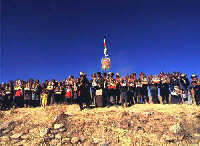
The Tibetans believe in Tibetan Buddhism, i.e. Lamaism. In the past, there were many traditional festivals relating the religious activities. Tibetan calendar is based on the Yin -Yang (lunisolar) calendar, which consists of "five elements" (wood, fire, earth, gold and water). Twelve animals symbolize the calendar assorted by Yin-Yang. A round needs 60 years. And the new year of Tibetan calendar is the most important festival.
On the 15th of the first month of Tibetan calendar, it is the custom with the local people to celebrate the Ghee Light Festival. On April 15, it is the fine day to memorize the Buddha birthday and the entrance of Princess Wencheng in Tibet. In addition, there are also other festivals such as the Saga Dawa Festival, Xuedun Festival, Flower Light Festival and Wangguo Festival.
Tibetan New Year
It is the grandest and most impassioned traditional festival. From January 1 to 15 of Tibetan calendar, it lasts 15 days. As the whole ethnic minority believes in Buddhism, the festival is full of the religious atmosphere. It is actually a recreation for deity and Tibetans, a folk festival that combines worship with celebration.
The preparation for the New Year generally starts in early December of Tibetan calendar. In addition to special purchase for the festival, every family makes a so-called "Corns Dipper", i.e. Zamba (roasted highland-barley) mixed with fried kernels and ghee at both sides of the wood box painted in colorful patterns, on which are inserted flowers made of highland-barley spikes and ghee. Besides, a bowl of highland-barley seeds are soaked to grow green shoots about 5 cm. The "Qiema" and shoots are offered on the center of the altar to pray for a bumper harvest in the next year.
When the festival is approaching, men are busy in tidying up the courtyard, and women make elaborate "Kasai", a sort of cooked wheaten food in the shape of ears, butterfly, bars, squares and rounds, painted and wrapped with granulated sugar. It is served both as artwork for the decoration of the altar, and as dishes for the guests. The assortment of "Kasai" generally stands for hardworking, wisdom and warm-heart. It is an attractive show in the festival.
December 29 of Tibetan calendar coincides with the eve of the New Year. On this day, the curtains should be renewed and the roof painted with Jing-Fan (a sort of fabric imprinted with lections, the auspicious Cross- marks are drawn with chalk on the door, balks and kitchen, in order to add animation to the festival. On the evening, all families sit together to have the dinner "Gutu", which is similar to the family reunion dinner in Hans.
"Gutu" is a sort of conjee made of "Yita" (cooked dough), mutton and ginseng. Before cooking, the hostess respectively packs in "Yita" some objects such as stones, wool, chili, charcoal and coins etc. The one who has it must spit out in public, foreshowing his fate and heart. The stones stand for cruelness, wool for charity, charcoal for evil mind, chili for plausibility and coins for fortune. With one for each, people talk to each other then start laughing, which reaches an upsurge of animation. Then, a magic woman and two bowls will be figured with "Zamba" and the residues of the "Gutu" and bones are to be dumped into such two bowls, which will be carried by a woman to throw outside. The woman is followed by a man taking a bundle of fired hay and reciting, "Come out, the demon! Show you up!" It means to let the fired hay burn the magic woman and food residues into ashes. In the meantime, children will set off firecrackers to drive out the evil and welcome a lucky new year.
On the 1st day of the Tibetan New Year, the hostess gets up first. Around 5:00 a.m., she will cook a pot of "Qianggu" i.e. highland-barley wine mixed with "Zaoba", brown sugar and raw milk, one portion for each one. Before the family members get up, they will drink off it on the bed, and go on sleeping. The hostess will seat at the window and wait for the sunrise. When the first sunrays occur in the morning, she hurries to carry the pail and fetch the first pail of water in the New Year from a river or a well. It is said that the water fetched at this time is the purest and sweetest. The one who gets it will avoid suffering from many disasters in the New Year.
The day breaks. All of the family members put on new clothes. After washing, the junior starts making the New Year's greeting to the eldership. They wish each other with good luck, and then have the breakfast. They propose each other to a toast of highland-barley wine. In pasturing areas, the hostess will prepare the cooked sheep heads according to the family members. Putting on the food table, she presents them to the eldest man of the family, who, according to the age, will distribute one for each with a sheep head and a knife. All sit around the burner and eat the sheep head meat while greeting to each other for the domestic peace, family and livestock prosperity. On the first day of the New Year, people stay at home and receive no visitors. Few road-walkers are seen in the street. The celebration and Buddhist ceremony are held only at home.
On January 2, friends and relatives start visiting and exchanging the New Year's greeting. Once paying a visit, the guests should greet to the host "Happy New Year". The host stays in front of the door welcoming the guests. The guests will pick up a pinch of "Zamba" and some grains of highland-barley by his thumb, index and middle fingers, swinging in the air to show their respect to the God; after then, they will pick up a pinch of "Zamba" and highland-barley and eat them to show their thanks for the host's kindness. Then they sit down, drink and talk. Since that day, the folk artists will go around and perform the Tibetan Opera and "Zhega" (a sort of singing-and-talking folk performance)
The richer families will make the agreement with the folk artists in advance, inviting them to perform in their families in time. Without the invitation, the artists can also offer themselves to drop around for the performance. The "Zhega" actor wear a white mask and take a crabstick, singing the impromptu lyric to please the host, such as how pretty the hostess looks, how wise the host is and the good wishes for the family in the New Year, etc. They will be rewarded with fine wine and meat generally. At the street corners and in the village, people also hold public dance parties and Tibetan operas.
Molang Qinbo Festival
It means the Large Dharma Transmission Ceremony, which is held on January 15 of Tibetan calendar. It originated from the first praying ritual initiated by the Zongkeba in Tibet in 1409. During the ceremony, the lamas from the three large temples and other monasteries will assemble in the city, reciting the scripture in groups. In addition, the examination will be given to acquire the "Gexi" scholarship degree. During February, another dharma ceremony comes off, which is named "Congjue" in Tibetan. The activities are similar to those of the Large Dharma Transmission Ceremony. The only difference between them is that "Congjue" ceremony is smaller than the other. Therefore, it is referred as the Small Dharma Transmission Ceremony.
Xuedun Festival
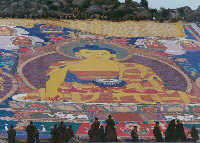
Each year on July 1 of Tibetan calendar, it is time for the "Yoghourt Feast". At that time, every family will make a large amount of yoghourt. Later on, the Tibetan opera was added. During the festival, many people will take ghee canister, teapot, vacuum flask and food, and go out to find a place with beautiful scenery to enjoy wine and tea.
Bathing Festival
It is one of special festivals in Tibet, which takes place on June 6 - 12 in every Tibetan calendar year, lasting 7 days, referred as the "Bathing Week".
Legend has it that in the paste a rare plague occurred in the Qinghai-Tibet Plateau. Many people and livestock died. The merciful Kwan-yin dispatched seven fairies to fetch seven bottles of saint water from the "Jade Liquid Pool" and pour them in all rivers in Tibet. That night, people dreamed about a sick, scraggy and scarred girl bathing in the clean river, and then she recovered completely. Since then, during the seven days when the "Venus" appears every year, all of people from cities, countryside and pasturing areas will go to the shores of rivers, lakes and brooks, setting up tents and drapery, extending mats and enjoying swimming and playing in the water. Women also do bathing in water without a qualm. At noon, all family members have picnic and taste the mellow highland-barley wine and fragrant ghee tea. At the sunrise, they come here and at the sunset they return home. They spend the annual traditional festival in the free and joyful way they like.
Looking at Fruit Festival
Prior to the autumn festival of each year, people extend to each other the invitation for dinner and various picnics to welcome the autumn festival. They also celebrate the Bathing Festival, Winter Festival and other festivals.
Burning Light Festival
It is the religious activity to memorize Zongkaba, the founder of the Gelug Sect of the Tibetan Buddhism. It is held on August 15 of Tibetan calendar. On the day, all the temples and monasteries and herds from various villages will keep the ghee light burning day and night on the altars inside and outside the temples and sutra halls, no matter they are large or small. People dress up and group in front of the monastery to chant the scripture for the great masters of Buddhism. They chant aloud the "Six Characters True Scripture". They pray for themselves to the Buddha with kowtowing. Men from all villages run on horses with cypress twigs they jave prepared and gather in front of the divine altar near the tree, praying aloud. The great Weisang Ceremony will be held there. Here and there crowd the people, and small colorful banners printed with lions, tigers, dragons are thrown into the sky. After then, the riders show their horsemanship for the monasteries and villagers; men and women perform the Guozhuang Dance. The elder sit on the platform drinking and chatting. The singers sing the greeting songs while the eloquent actors chant the Tibetan folk long verses and The Story of King Gesar. It is not until the moonrise that they return home with the young and the old, reciting the "Six Characters True Scripture" aloud.
Tibetan Meadow Festival
The Tibetan Meadow Festival is also called Tibetan calendar Year. It is one of the traditional Tibetan festivals, which is similar to the Spring Festival of the Hans. It is celebrated on the early first month of Tibetan calendar. The festival lasts about one week.
Prior to the festival, every family tidies up the house. According to the customs of the Tibetans, people pour out sewage and rubbish toward the west when the sun is setting down the west. It means to have all stuff harmful to the human health disappear. Afterward, every family brews highland-barley wine, makes seedcakes and cheesecakes, and prepares blood sausage, mutton sausage, fresh milk and other festival food.
On the 1st day of the Tibetan New Year, the hostess of every family has to get up at dawn. She goes to the riverbank with a pail to carry water. She puts some fresh milk in the water and carries back. All family members wash up with the water. After washing and dressing, all enjoy playing with the "Dragon Lantern" and burn joss sticks to pray for the abundance on grassplot and water as well as strong livestock. After then, the family will have a dinner together. Prior to the dinner, each one has to take some "Zamba" flour, which means he or she is a "Zamba" eater and bears the ancestors in mind. During the first three days of the festival, it is a custom for the villagers not to go out of the village. All of them watch the sorcerer's dance in a trance, which is a kind of the traditional religious dance. The dancers wear a mask and dress cassock, dancing to the accompaniment of cymbals, gongs, drums and trumpet shells. They take a rest for a while and continue to perform until it is over.
In addition, young men and girls dance and sing to the rhythm of the sounds of gongs and drums, flute and Erhu (a two-stringed bowed instrument). In three days, people bring along with the old and young to drop around in the village greeting to each other for a merry festival.
During the festival, according to the local traditional custom, the girls and married women often "rob" foods from men, who neither complain nor oppose. Young men in some villages hold the "yak race". During the game, two persons stand around 10 meters away from each other, both holding a yak string marked in the middle. The one who draws the rival over the mark will be the winner. When drawing, they keep deadlock for three minutes, then take a rest for one minute to go on. The one who draws the rival over the mark in at least 2 of 3 rounds will be the final winner. At night, girls and young men mainly gather inside or outside the village singing and dancing.
Gyantse Damma Festival

The Gyantse Damma Festival has a history of more than 500 years.
It is said that Gyantse King, Pabasangbu had a lot of prestige in the Geshar Dynasty. After his death, his disciples held the worship to memorize him. But it was interrupted because of the war. In 1408, the Gongsang Raopa King, the son of Paba Sangbu, resumed the worship.
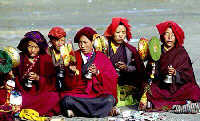
From April 10 to 27 of Tibetan calendar, Gongsang Raopa held the worship and recreational activities to memorize his father. Activities include the display of Buddha Portrait, sorcerer's dance in a trance, wrestling and bearing contest. When the Zhaxi Raodan enthroned the Gyantse-King in 1447,the horsemanship,archery, Tibetan opera, dancing and singing were supplemented, forming the Gyantse Dama Festival still being observed today.
Saga Dawa Festival
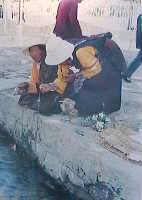
April 15 of Tibetan calendar is a special Tibetan festival - Saga Dawa, which means the month of Shisu in Tibetan language (Shisu is one of 28 horoscopes). As it appears in April of Tibetan calendar, the Shisu is named in reference to Saga Dawa. Legend has it that the birth, accomplishment, and death of Sakyamuni all happened to be on April 15. Therefore, various activities have to be held in this month to commemorate him. As time passes by, all of these activities have formed the large Zhuanjing (turning scripture) convocation.
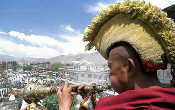
"Turning Scripture" means that the scripture chanter walks in circle along the fixed route, which is considered as one of the rogation rituals. In Lhasa, there are in total three itineraries: one is the inner ring about 500 meters long, and the chanter makes a round in the main hall of Dazhao Temple,where full of Wheels of Law are set up; one is the middle ring, about 1,000 meters long, encircling the Dazhao Temple, and another one is the outer ring in the total length of 5,000 meters. Turning Scripture makes the most magnificent scene during the Saga Dawa Festival. On the first day of the festival, hordes of chanters show up in the street and the upsurge will occur on the 15th of Tibetan calendar. From 2:00 am to the evening, people crowd to celebrate the festivals.
|



